The Pesach Haggadah PDF is a comprehensive guide for the Passover Seder, outlining rituals, prayers, and the Exodus story․ It offers traditional and modern interpretations, ensuring accessibility for all participants․ Available in various languages and formats, it simplifies preparation and enhances the Seder experience with ease and depth․
Overview of the Haggadah
The Haggadah is a sacred text guiding the Passover Seder, detailing the Exodus story and rituals․ It includes prayers, blessings, and symbolic acts like eating matzah and reciting the Four Questions; Traditional Haggadahs feature Hebrew texts with translations, while modern versions incorporate creative elements for engagement․ Many Haggadahs are now available as downloadable PDFs, offering convenience and accessibility․ They cater to diverse audiences, from families to Messianic Jews, ensuring the Seder experience remains meaningful and inclusive․ The Haggadah’s structure ensures the story of freedom and redemption is shared across generations, blending tradition with contemporary interpretations․
Importance of the Haggadah in Passover Celebrations
The Haggadah is central to Passover, serving as a guide for the Seder․ It preserves the Exodus narrative, ensuring the story of freedom is passed to future generations․ By recounting the Ten Plagues and the parting of the Red Sea, it connects participants to their heritage․ The Haggadah also fosters engagement through rituals like the Four Questions and Elijah’s Cup, making the Seder interactive and meaningful․ Its availability as a PDF enhances accessibility, allowing families to easily prepare and lead the service․ Ultimately, the Haggadah ensures the Seder remains a powerful celebration of liberation and unity, bridging tradition and modern practice․
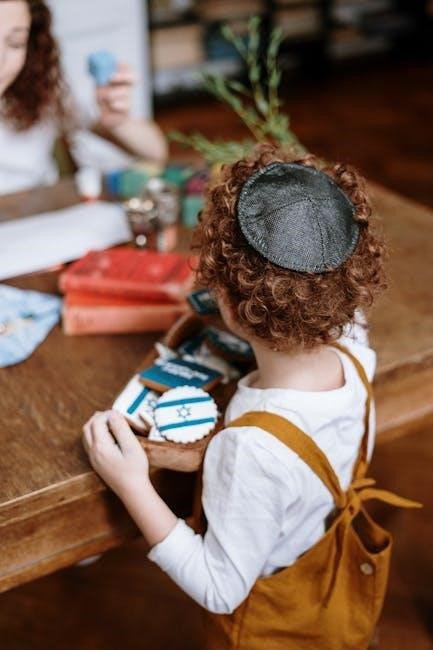
Structure of the Haggadah
The Haggadah is structured to guide participants through the Passover Seder, ensuring the story of Exodus is retold with meaningful rituals․ It begins with Kiddush, sanctifying the holiday, followed by washing hands and dipping vegetables․ The breaking of matzah symbolizes humility and freedom․ The Seder plate holds symbolic items like maror (bitter herbs) and charoset, representing the bitterness of slavery and the mortar used by Hebrew slaves․ The Four Questions and the recitation of the Exodus story highlight the liberation narrative․ The Haggadah concludes with the drinking of four cups of wine, each representing a promise of redemption, and the recitation of Hallel, songs of praise․ This structured format ensures a cohesive and spiritually enriching Seder experience․
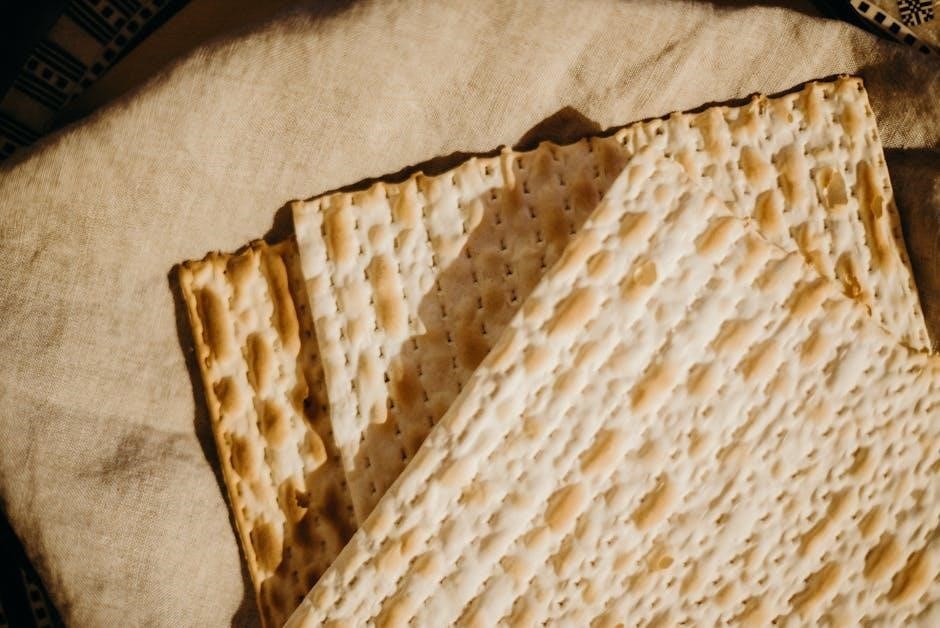
Historical and Cultural Significance
The Pesach Haggadah PDF holds profound historical and cultural significance, preserving the Exodus story and rituals, while connecting generations to their heritage and the universal theme of liberation․
Origins and Evolution of the Haggadah
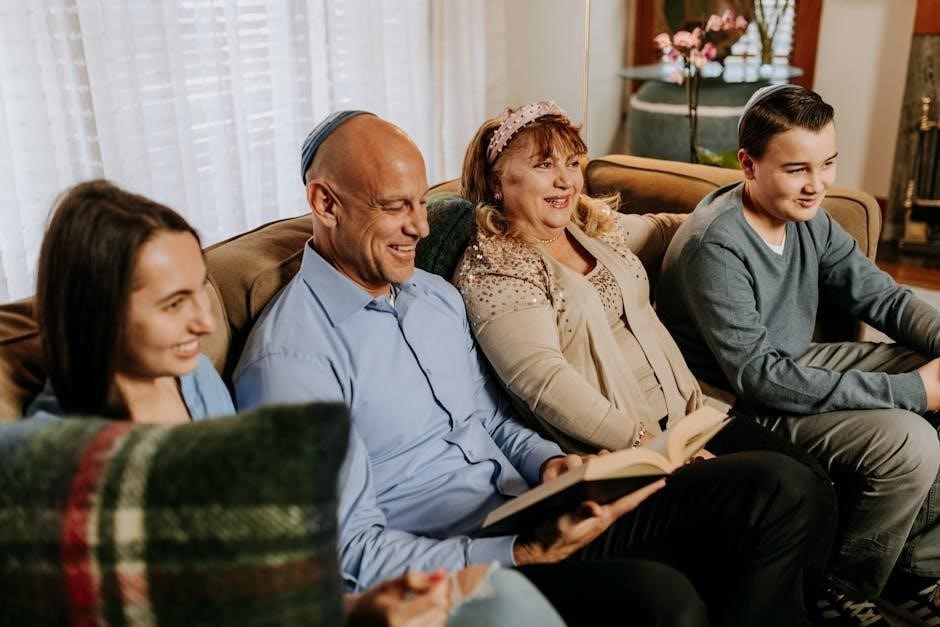
The origins of the Haggadah trace back to ancient Jewish tradition, with its core elements rooted in the Exodus narrative․ Over centuries, it evolved from oral recitations to written texts, incorporating prayers, songs, and rituals․ The earliest known Haggadahs were simple, focusing on the Seder’s essential components․ By the Middle Ages, they became more detailed, featuring commentaries and illustrations․ Modern versions, including Pesach Haggadah PDFs, reflect diverse cultural influences, offering translations and innovative designs․ This evolution ensures the Haggadah remains relevant, blending tradition with contemporary needs while preserving its historical essence․
Cultural Impact of the Haggadah
The Haggadah has become a vibrant cultural artifact, transcending its religious origins to inspire art, music, and literature․ Its themes of freedom and redemption resonate universally, making it a symbol of liberation and hope․ Through illustrations, translations, and adaptations, the Haggadah has evolved into a diverse cultural expression, reflecting Jewish identity and heritage․ Modern versions, such as the 30 Minute Haggadah and Messianic adaptations, cater to varied audiences, ensuring its relevance across generations․ The Haggadah’s influence extends beyond the Seder table, with its stories and rituals inspiring creative works and fostering a sense of community․ Its cultural impact lies in its ability to connect people to their history while remaining a dynamic, living tradition․
Historical Texts and Illustrations in the Haggadah
Haggadahs have long been enriched with historical texts and illustrations, preserving traditions and enhancing the Seder experience․ Ancient manuscripts, like the 13th-century Sephardic Haggadah from Catalonia, feature intricate designs and Hebrew calligraphy, reflecting the artistic and religious practices of their time․ Illustrations often depict scenes from the Exodus, such as Moses parting the Red Sea, while texts recount the story of liberation․ These elements serve as a bridge between past and present, making the Haggadah a living historical document․ Digital versions, such as downloadable PDFs, now offer access to these treasures, ensuring their legacy endures for future generations․ The combination of sacred text and visual art underscores the Haggadah’s enduring cultural and spiritual significance․
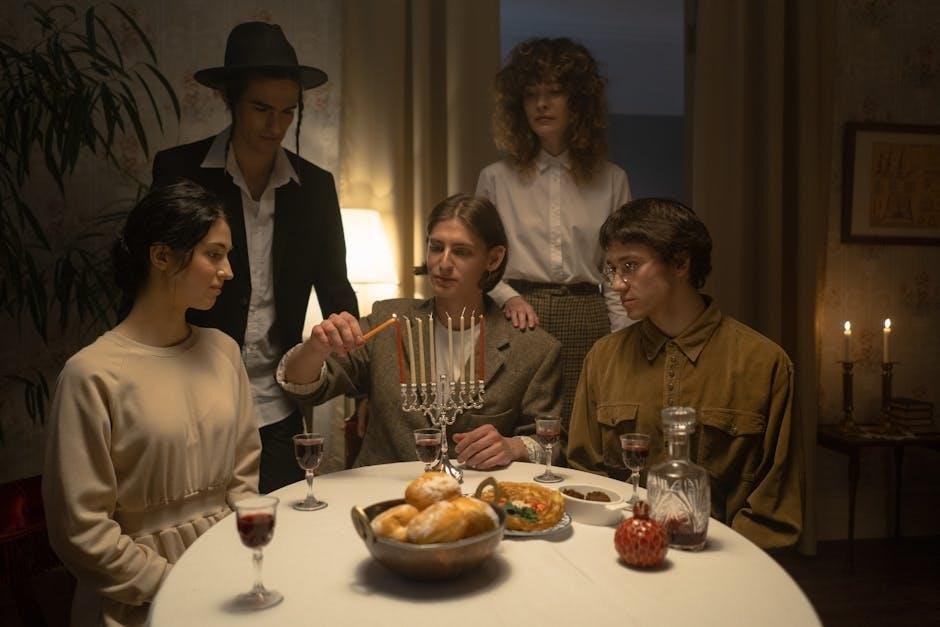
Types of Haggadahs
Haggadahs come in various forms, including traditional, modern, and specialized versions, each offering unique perspectives and customs to enrich the Passover experience for diverse audiences․
Traditional Haggadahs
Traditional Haggadahs are revered for their adherence to ancient customs and texts, preserving the rich history of the Passover Seder․ These texts typically include the complete Hebrew liturgy, English translations, and detailed instructions for rituals such as Kiddush, the Four Questions, and the eating of matzah․ Many traditional Haggadahs also feature commentaries from esteemed scholars and rabbis, offering deeper insights into the Exodus story․ They are often illustrated with classic artwork, enhancing the spiritual connection during the Seder․ Families and communities who value continuity with Jewish tradition often use these Haggadahs to ensure the authenticity and solemnity of the occasion․ Their timeless appeal makes them a cornerstone of Passover celebrations worldwide․
Modern and Innovative Haggadahs
Modern and innovative Haggadahs offer fresh perspectives and creative approaches to the Passover Seder, making the tradition more accessible and engaging for contemporary audiences․ These Haggadahs often incorporate diverse voices, inclusive language, and modern themes, such as social justice or environmental awareness․ Some feature innovative designs, including digital versions and interactive elements like videos or QR codes․ Others cater to specific groups, such as children or interfaith families, with visuals, stories, and activities that foster participation․ These adaptations ensure the Haggadah remains relevant while preserving its core spiritual and cultural significance․ By blending tradition with creativity, modern Haggadahs inspire new ways to connect with the Exodus story and its universal message of freedom․
Specialized Haggadahs (e․g․, for Children, Messianic Jews)
Specialized Haggadahs cater to diverse audiences, ensuring inclusivity and relevance for specific groups․ For children, these Haggadahs often feature colorful illustrations, engaging stories, and simplified language to captivate young minds․ Messianic Jewish Haggadahs blend traditional Passover rituals with Christian theological perspectives, creating a unique worship experience․ Some versions are designed for interfaith families or those with special needs, offering adaptable rituals and explanations․ These Haggadahs also incorporate modern themes, such as social justice or environmental awareness, making the Passover story resonate with contemporary values; By tailoring the Seder experience to different needs, specialized Haggadahs ensure that everyone can actively participate and connect with the Exodus narrative in a meaningful way․
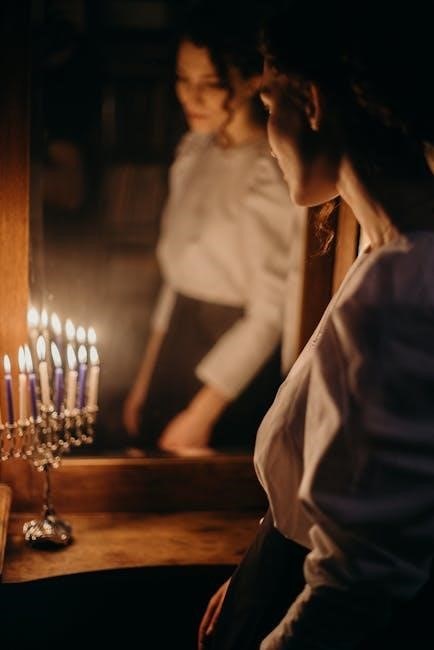
Downloading and Using Pesach Haggadah PDFs
Downloading Pesach Haggadah PDFs is a convenient way to access traditional and modern versions for Seder․ Websites like Sefaria and My Jewish Learning offer free downloads, ensuring easy preparation and participation in Passover rituals․
Where to Find Free Haggadah PDFs Online
Free Haggadah PDFs are widely available online, offering convenient access to Passover resources․ Websites like the National Library of Israel provide historic and modern versions, while platforms such as Sefaria and My Jewish Learning offer downloadable Haggadahs in multiple languages․ These sites feature traditional, family-friendly, and interactive designs to suit various needs․ Additionally, organizations like the Union for Reform Judaism and Chabad share customizable Haggadahs, allowing users to tailor the text for their Seder․ These resources ensure that everyone can participate meaningfully in the Passover celebration, regardless of their background or preferences․
How to Download and Print Haggadah PDFs
Downloading and printing Haggadah PDFs is a straightforward process․ Start by selecting a Haggadah that suits your needs, such as traditional, family-friendly, or modern designs․ Visit reputable websites like the National Library of Israel or Chabad․org, which offer free downloads․ Once you’ve chosen a Haggadah, click the download link to save the PDF to your device․ Ensure your printer is set to print in color or black and white, depending on the design․ Print on standard paper or cardstock for durability․ Some Haggadahs are designed for double-sided printing, so adjust your printer settings accordingly․ Finally, bind the pages or staple them for easy use during the Seder․ This ensures everyone has a copy to follow along comfortably․
Popular Websites for Haggadah Downloads
Several websites offer free or paid Haggadah PDF downloads, catering to various preferences․ Chabad․org provides traditional Haggadahs with Hebrew/English text, ideal for those seeking authenticity․ Sefaria․org offers customizable options, allowing users to create personalized Haggadahs․ The National Library of Israel features historical and artistically illustrated Haggadahs, perfect for educational purposes․ MyJewishLearning․com and PassoverHaggadah․com provide modern and family-friendly versions, including interactive elements․ Additionally, Etsy․com offers unique, artist-designed Haggadahs for those looking for a creative touch․ These platforms ensure easy access to diverse Haggadahs, making it simple to find one that suits your Seder style and needs․
Guidelines for Using Haggadah PDFs in Seder
Using a Pesach Haggadah PDF in your Seder can enhance the experience if done thoughtfully․ First, ensure the PDF is downloaded and printed clearly, with readable text in both Hebrew and English if needed․ Distribute copies to all participants beforehand to encourage active engagement․ Follow the Seder order as outlined in the Haggadah, pausing for questions and discussions to involve everyone, especially children․ For interactive elements, consider adapting the text to suit your group’s needs․ Make sure devices are fully charged if using digital versions, and have a backup plan in case of technical issues․ This approach ensures a meaningful and inclusive Seder for all participants․
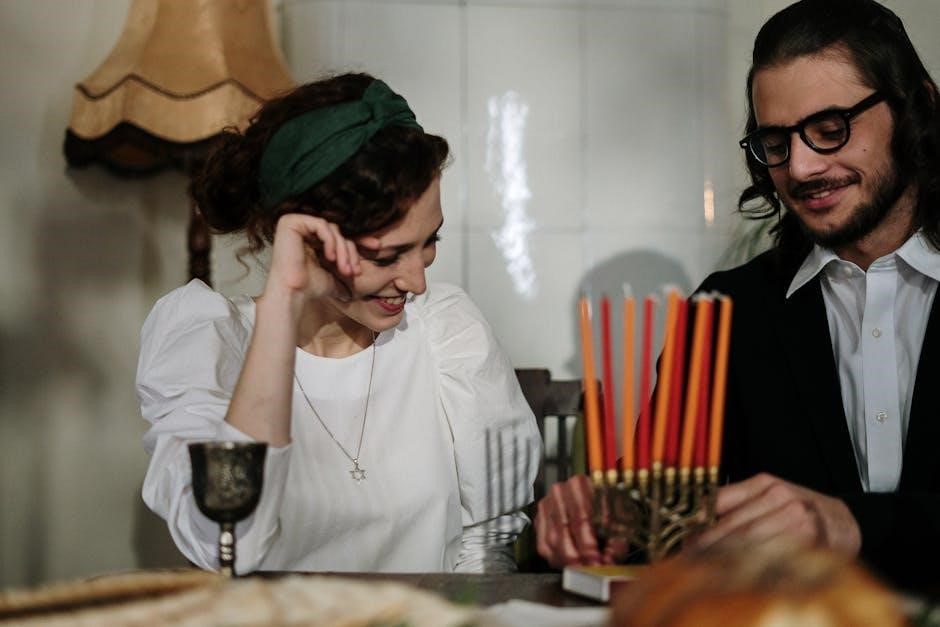
Key Sections of the Haggadah
The Haggadah includes Kiddush, washing hands, breaking matzah, the Four Questions, eating matzah and maror, the Ten Plagues, Elijah’s Cup, and Hallel, guiding the Seder ritually․
Kiddush and the First Cup of Wine
Kiddush, a blessing over wine, initiates the Passover Seder, sanctifying the day and its observance․ The leader raises the first cup of wine, reciting the blessing, and participants follow․ This ritual symbolizes freedom and gratitude, setting the tone for the Seder․ The cup represents God’s promise of redemption, central to the Exodus story․ Traditionally, the Kiddush is recited in Hebrew, with translations provided in Haggadah PDFs for inclusivity․ This act unites all participants, reflecting the collective celebration of liberation and joy․ The first cup is a powerful reminder of the Seder’s purpose and the enduring themes of Passover․
Washing Hands and Dipping Vegetables
Washing hands, known as urchatz, is a ritual act performed before dipping vegetables in water or saltwater․ This practice symbolizes purification and readiness for the sacred rituals of the Seder․ Typically, parsley or another vegetable is dipped, representing the tears of the Israelites during bondage․ The act of dipping is a sensory experience, engaging participants and connecting them to the Exodus story․ This tradition reflects the themes of freedom and gratitude, emphasizing the journey from oppression to liberation․ The Haggadah PDF guides participants through this step, ensuring understanding and meaningful observance․ This ritual is a poignant reminder of the Seder’s purpose and the enduring legacy of Passover traditions․
Breaking the Matzah and the Seder Plate
Breaking the matzah, known as Yachatz, is a symbolic act during the Seder, representing the brokenness of slavery and the hope for freedom․ The leader breaks the middle matzah, hiding one piece as the Afikomen, which children later find, ensuring engagement and excitement․ The Seder plate, a central element, holds six items: Charoset (mortar), Maror (bitter herbs), Chazeret (another bitter herb), Karpas (vegetable for dipping), and a roasted shank bone․ These items visually recount the Exodus story, with the matzah placed above as a reminder of the haste in leaving Egypt․ The arrangement and breaking of the matzah are pivotal moments, fostering reflection on freedom and gratitude, and are meticulously guided in the Haggadah PDF to ensure meaningful participation for all․
The Four Questions and the Story of Exodus
The Four Questions, traditionally recited by the youngest child, mark a pivotal moment in the Seder․ These questions highlight the unique customs of Passover, such as eating matzah and maror, sparking curiosity and engagement․ The Haggadah then unfolds the story of Exodus, recounting the Israelites’ journey from slavery to freedom․ This narrative is central to the Seder, emphasizing themes of liberation and divine intervention․ Visual aids and storytelling techniques in the Haggadah, such as illustrations and poetic recitations, make the Exodus story accessible and memorable․ The recitation of the Ten Plagues and the singing of Dayenu reinforce the miracle of freedom, creating a meaningful connection for participants of all ages․ This section ensures the legacy of Passover is passed down through generations․
Eating Matzah and Maror
Eating matzah and maror are central rituals in the Passover Seder, symbolizing the Israelites’ hasty departure from Egypt and the bitterness of their slavery․ The Haggadah guides participants through these acts, beginning with the blessing over matzah, ha motzi, and the specific blessing for eating matzah, al achilat matzah․ Maror, often horseradish or romaine lettuce, is eaten next, representing the bitterness of oppression․ Many Haggadahs include instructions for preparing the matzah-maror-charoset sandwich, a tradition linked to Hillel’s practice․ Visual aids in some PDFs illustrate these steps, ensuring clarity for all participants․ These rituals not only honor the Exodus story but also invite reflection on freedom and resilience, making them a poignant part of the Seder experience․

The Ten Plagues and the Second Cup of Wine
The Ten Plagues and the Second Cup of Wine are pivotal moments in the Passover Seder, recounting the divine punishments upon Egypt․ The Haggadah details each plague, from blood to darkness, as a demonstration of God’s power and justice․ After reciting the plagues, participants pour the second cup of wine and recite the blessing, symbolizing joy and liberation․ Many Haggadahs include illustrations or songs to enhance the narrative, making it engaging for all ages․ Spilling wine during the recitation of the plagues is a common tradition, expressing sorrow for the suffering of others․ This ritual serves as a reminder of the Exodus story’s depth and the universal quest for freedom, while also fostering reflection on the balance between justice and compassion․
Elijah’s Cup and the Open Door
Elijah’s Cup is a cherished tradition in the Passover Seder, symbolizing hope and redemption․ A fifth cup of wine is poured but not drunk, representing Elijah’s role as a harbinger of peace․ Families open their doors, inviting Elijah’s spirit to join, reinforcing messianic hopes․ This ritual, often accompanied by singing “Elijah the Prophet,” unites participants in a shared vision of a harmonious future․ The untouched cup reminds us of Elijah’s symbolic presence, while the open door signifies hospitality and faith․ This moment blends tradition with aspiration, creating a meaningful connection to Jewish heritage and universal ideals of freedom and harmony․ It is a powerful reminder of the Seder’s enduring message of hope and redemption․
Hallel and the Fourth Cup of Wine
The recitation of Hallel, a series of Psalms expressing praise and gratitude, marks a joyful conclusion to the Passover Seder․ Participants sing these sacred texts, reflecting on divine redemption and the miracles of the Exodus․ The fourth cup of wine, representing the fourth promise of redemption in Exodus, is drunk during this section․ This act symbolizes completion and fulfillment, as the Seder draws to a close․ Hallel is often sung with enthusiasm, creating a sense of unity and celebration among those gathered․ The combination of song and wine underscores the themes of freedom, thanksgiving, and hope, leaving participants with a profound sense of connection to the story and its timeless message․ This ritual embodies the spirit of Passover, bridging past and present․ There’s more to explore in the Haggadah, but this moment stands as a powerful conclusion to the evening․ The fourth cup and Hallel serve as a heartfelt farewell to the Seder, inspiring reflection and renewal․ The Psalms chosen for Hallel are carefully selected to align with the narrative of liberation and divine intervention․ As the final notes of Hallel fade, the Seder officially ends, leaving a lasting impression of joy and gratitude․ This tradition ensures that the story of Passover remains vivid and relevant for future generations․ The fourth cup and Hallel are integral to the Haggadah, reinforcing its core themes and leaving participants with a sense of fulfillment and connection to their heritage․ The act of drinking the fourth cup and reciting Hallel is a meaningful way to honor the Exodus and celebrate the enduring spirit of freedom․ By engaging in these rituals, families and communities reaffirm their commitment to preserving and passing down the traditions of Passover․ The Haggadah guides participants through this sacred journey, ensuring that each element, including Hallel and the fourth cup, enriches the Seder experience․ As the evening concludes, the memories and lessons of the Haggadah remain, inspiring continued reflection and observance․ The fourth cup and Hallel are not just rituals but a celebration of faith, heritage, and the universal quest for freedom․ They remind us that the story of Passover is not just a historical event but a living, breathing narrative that continues to inspire and guide us today․ The fourth cup and Hallel are a testament to the enduring power of tradition and the human spirit’s capacity for hope and resilience․ As the Seder comes to a close, these elements leave participants with a renewed sense of purpose and connection to their faith․ The fourth cup and Hallel are a fitting conclusion to the Haggadah, encapsulating the essence of Passover and its timeless message of liberation and redemption․ The Psalms of Hallel, sung with passion and devotion, ensure that the spirit of Passover lingers long after the Seder ends․ The fourth cup and Hallel are a celebration of faith, freedom, and the unbreakable bond between generations․ They serve as a poignant reminder of the importance of preserving and honoring our traditions․ The Haggadah’s inclusion of Hallel and the fourth cup ensures that the Seder remains a deeply meaningful and transformative experience for all who participate․ These rituals are a cornerstone of the Passover observance, connecting past, present, and future in a shared celebration of freedom and hope․ The fourth cup and Hallel are a testament to the power of faith and tradition, leaving an indelible mark on those who partake in the Seder․ The Haggadah’s guidance through these moments ensures that the story of Passover is not just told but lived and experienced by each generation․ The fourth cup and Hallel are a celebration of heritage, a declaration of faith, and a commitment to the values of freedom and justice․ They are a fitting conclusion to the Seder, leaving participants with a sense of fulfillment and renewal․ The Psalms of Hallel and the fourth cup of wine are a powerful reminder of the enduring legacy of Passover and its universal message of hope and liberation․ The Haggadah’s inclusion of these elements ensures that the Seder remains a vibrant and meaningful tradition for generations to come․ The fourth cup and Hallel are a celebration of faith, family, and freedom, reinforcing the core values of Passover and inspiring continued observance and reflection․ The Haggadah guides participants through this sacred journey, ensuring that each element, including Hallel and the fourth cup, enriches the Seder experience․ The fourth cup and Hallel are a meaningful way to honor the Exodus and celebrate the enduring spirit of freedom․ By engaging in these rituals, families and communities reaffirm their commitment to preserving and passing down the traditions of Passover․ The fourth cup and Hallel are integral to the Haggadah, reinforcing its core themes and leaving participants with a sense of fulfillment and connection to their heritage․ The act of drinking the fourth cup and reciting Hallel is a meaningful way to honor the Exodus and celebrate the enduring spirit of freedom․ By engaging in these rituals, families and communities reaffirm their commitment to preserving and passing down the traditions of Passover․ The Haggadah guides participants through this sacred journey, ensuring that each element, including Hallel and the fourth cup, enriches the Seder experience․ As the evening concludes, the memories and lessons of the Haggadah remain, inspiring continued reflection and observance․ The fourth cup and Hallel are a testament to the enduring power of tradition and the human spirit’s capacity for hope and resilience․ As the Seder comes to a close, these elements leave participants with a renewed sense of purpose and connection to their faith․ The fourth cup and Hallel are a fitting conclusion to the Haggadah, encapsulating the essence of Passover and its timeless message of liberation and redemption․ The Psalms of Hallel, sung with passion and devotion, ensure that the spirit of Passover lingers long after the Seder ends․ The fourth cup and Hallel are a celebration of faith, freedom, and the unbreakable bond between generations․ They serve as a poignant reminder of the importance of preserving and honoring our traditions․ The Haggadah’s inclusion of Hallel and the fourth cup ensures that the Seder remains a deeply meaningful and transformative experience for all who participate․ These rituals are a cornerstone of the Passover observance, connecting past, present, and future in a shared celebration of freedom and hope․ The fourth cup and Hallel are a testament to the power of faith and tradition, leaving an indelible mark on those who partake in the Seder․ The Haggadah’s guidance through these moments ensures that the story of Passover is not just told but lived and experienced by each generation․ The fourth cup and Hallel are a celebration of heritage, a declaration of faith, and a commitment to the values of freedom and justice․ They are a fitting conclusion to the Seder, leaving participants with a sense of fulfillment and renewal․ The Psalms of Hallel and the fourth cup of wine are a powerful reminder of the enduring legacy of Passover and its universal message of hope and liberation․ The Haggadah’s inclusion of these elements ensures that the Seder remains a vibrant and meaningful tradition for generations to come․ The fourth cup and Hallel are a celebration of faith, family, and freedom, reinforcing the core values of Passover and inspiring continued observance and reflection․ The Haggadah guides participants through this sacred journey, ensuring that each element, including Hallel and the fourth cup, enriches the Seder experience․ The fourth cup and Hallel are a meaningful way to honor the Exodus and celebrate the enduring spirit of freedom․ By engaging in these rituals, families and communities reaffirm their commitment to preserving and passing down the traditions of Passover․ The fourth cup and Hallel are integral to the Haggadah, reinforcing its core themes and leaving participants with a sense of fulfillment and connection to their heritage․ The act of drinking the fourth cup and reciting Hallel is a meaningful way to honor the Exodus
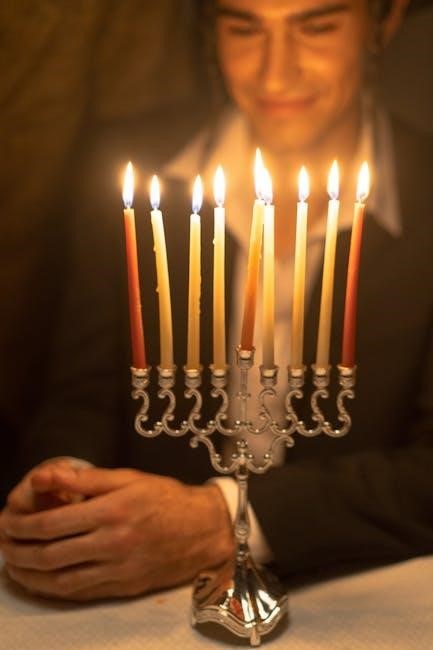
Family-Friendly and Interactive Haggadahs
Family-friendly Haggadahs incorporate engaging elements like stories, visuals, and activities to involve children and create a dynamic Seder experience; These versions often include interactive features to make the Passover story accessible and enjoyable for all ages, fostering participation and understanding․
Engaging Children in the Seder
Engaging children in the Seder is crucial for fostering their connection to Passover traditions․ Many Haggadah PDFs include interactive elements such as colorful visuals, simplified stories, and activities like the Four Questions, designed to capture young minds․ These resources often incorporate games, puzzles, and child-friendly language to make the Exodus story relatable and fun․ By involving children in rituals like hiding the afikomen or reciting blessings, families create meaningful memories and ensure the legacy of Passover is passed to future generations․ Interactive Haggadahs also encourage participation through songs and discussions, making the Seder an inclusive and joyful experience for all ages․
Interactive Elements in Modern Haggadahs
Modern Haggadahs often incorporate interactive elements to enhance the Seder experience․ These may include multimedia features like videos, audio clips, and clickable links within PDFs, allowing participants to explore additional content․ Some Haggadahs feature games, puzzles, or quizzes that engage attendees and encourage active participation․ Innovative designs might include QR codes linking to educational resources or musical accompaniments for Seder songs․ These elements cater to diverse learning styles and age groups, making the Seder more dynamic and inclusive․ By integrating technology and creative visuals, modern Haggadahs ensure that the Passover story remains vibrant and accessible, fostering deeper connections to the traditions and themes of the holiday․
Using Visuals and Stories to Enhance Participation
Visuals and storytelling are powerful tools in modern Haggadahs to engage participants of all ages․ Illustrated depictions of the Exodus story, vibrant diagrams of the Seder plate, and images of rituals create a visually rich experience․ Stories, both traditional and personal, bring the narrative to life, fostering emotional connections․ For children, colorful illustrations and relatable tales make the Seder more interactive and memorable․ Adults appreciate the depth added by historical and cultural narratives․ These elements ensure the Haggadah is not just a text but a dynamic guide that invites everyone to reflect, share, and celebrate the freedom story․ Visuals and stories transform the Seder into a shared journey of discovery and renewal․
The Pesach Haggadah PDF serves as a meaningful guide, preserving traditions while offering accessible resources for engaging and reflective Passover celebrations for all participants․

Final Thoughts on the Haggadah
The Haggadah is more than a guide for the Seder; it is a timeless storyteller, preserving the Exodus narrative and fostering connection across generations․ Its adaptability, seen in diverse versions like the 30-minute Seder and Messianic Haggadahs, ensures it remains relevant․ The availability of Pesach Haggadah PDFs has made it accessible to global audiences, blending tradition with modern convenience․ Whether traditional or innovative, the Haggadah’s core remains the celebration of freedom and unity․ As families and communities gather, the Haggadah continues to inspire reflection and joy, reminding us of the enduring power of storytelling and faith․ Embrace this sacred text to deepen your understanding and connection to Passover’s spirit․
Encouragement to Explore and Use Haggadah PDFs
Exploring and using Pesach Haggadah PDFs offers a convenient and enriching way to engage with the Passover Seder․ These digital resources provide accessibility to a wide range of traditional and modern interpretations, catering to diverse needs and preferences․ Whether you’re seeking a brief 30-minute Seder or a deeper, interactive experience, Haggadah PDFs make it easy to prepare and participate․ They are ideal for sharing with family and friends, ensuring everyone can follow along comfortably․ Embrace the flexibility and variety of Haggadah PDFs to create meaningful and memorable Seders, fostering connection and understanding of the Passover story․
